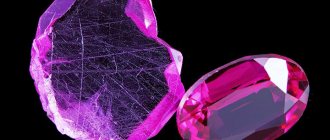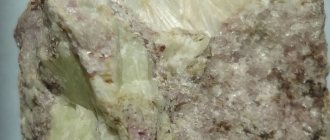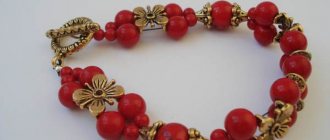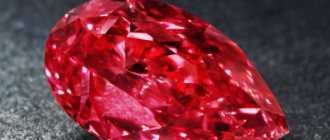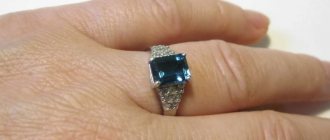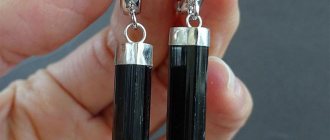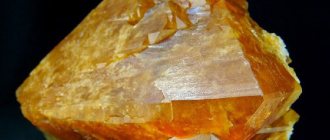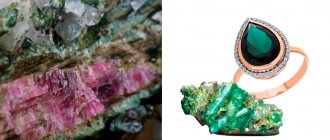Sitall - stone of the 21st century
In no way inferior to natural stones, the incredibly beautiful ceramic glass has won the love of jewelry masters. You will fall in love with this artificial stone and its unique shine at first sight. The properties of glass ceramics allow us to call it an analogue of natural stones. Crystallized glass doesn't look that simple at all.
Man-made mineral
The creator of the sitall cannot be named, because debates about this are still ongoing. They started changing the structure of glass two hundred years ago, so it’s difficult to say who was the first. In the 18th century, René Reaumur, a St. Petersburg and Parisian scientist, experimented with glass at high temperatures. He created a material similar to porcelain.
Two hundred years later, the USA became interested in glass crystallization. It is believed that in 1957, the American D. Stuckey developed a formula for growing an artificial mineral. The product was called pyroceram.
At the same time, in the USSR, blast furnace slag (metallurgical waste) began to be used to create a new synthetic rock. By combining the words “glass” and “crystal”, the resulting material was called “ceramic glass”.
History of origin
Many people are interested in ceramic glass (stone). What is this? We have heard more about artificial cubic zirconia, but information about glass ceramics is not so widespread. Sitall gemstone is a glass-crystalline material. Abroad, the technology for its production was developed earlier (in 1957). It belongs to the American Donald Stukey. , which produces these crystals, gave them the name “pyrokers.”
In the Soviet Union, Isaac Kitaigorodsky was involved in the development of glass ceramics. And many other Russian scientists contributed to the development of crystal technology. So, sitall (stone) - what is it, where did this name come from? The unusual word was formed from two chemical elements that make up this crystal. From sicilium (silicon) they took the syllable “si”, from aluminum - the syllable “al”, and the result was sitall. It is very similar in composition to volcanic rock and is classified as a high-temperature silicate glass.
Properties and types of Sitall
Sitall is a fairly heat-resistant material. And, unlike natural stones, it has no porosity on the surface at all. The increased density prevents it from conducting heat and electricity, and it is not afraid of chemical exposure. In addition to durability, add exceptional crystal clarity. Working with such a stone is easy and pleasant: it lends itself to any type of cut, can be of any color and size, you can realize the most daring ideas! In addition, glass ceramic is inexpensive.
SOKOLOV gold earrings with cubic zirconia and sitalls (go to catalog)
Jewelry stoneware is represented by dozens of types. The main ones include ametrine - it is a copy of a two-color stone, a mixture of amethyst and citrine. It is also worth noting paraiba stoneware - imagine a stone with a bright, thick turquoise blue, which is also called electric or neon. London glass-ceramic is not much different from smoky gray-blue topaz, only it does not fade in the sun. The glass-ceramic sultanite is also brighter and shimmers more clearly, and it is not at all afraid of the sun’s rays.
Silver ring SOKOLOV with cubic zirconia and sitalls (go to catalog)
The price of the stone depends on the color. The most expensive are red-ruby. Blues and light blues that imitate aquamarine are a little cheaper. The difference can be 10-20 percent.
physical characteristics
Experts describe the following physical and chemical properties of nanocrystals:
- hardness 6.5 – 7 units on the Mohs scale;
- low density 2.4-2.95 g/cm³;
- electrical strength 25-75 MV/m;
- high compression ratio;
- bending strength up to 350 MPa;
- high heat resistance;
- water absorption up to 0.01%;
- The material is heat-resistant, can withstand up to 1000 °C;
- temporary resistance 112-161 MPa;
- zero porosity;
- does not react with chemicals.
The synthetic product has all the positive properties of glass. They can be magnetic, radiotransparent, semiconductor.
The magic of Sitalla is a stone of change
If you dream of urgently changing something in your life, you definitely need a sitall amulet. It represents balance and peace. Therefore, if you wear it constantly, you can improve relationships with colleagues and family.
There is an opinion that if you keep a stone in your pocket and periodically touch it with your hand, you can induce psychic abilities. The gem will also help cope with depressive conditions; it prevents bad thoughts from lingering in the head and fills the soul with positive emotions.
Gold bracelet MASKOM with glass-ceramics (go to catalog)
Sitall can be called a fire stone, which is why it is suitable for Aries, Leo and Sagittarius, giving them peace of mind and impenetrable resilience in the face of troubles. But this stone is contraindicated for already calm Virgos and Pisces; it will make them apathetic and weak-willed.
The stone will bring self-confidence to all other zodiac signs.
Manufacturing process
Glass has a natural tendency to crystallize over time. It was this that scientists took as a basis when creating sitall. The manufacturing process of this material is reminiscent of glass ceramics. To begin with, prepare the starting materials - the charge. It may include several nucleators (components for clarification). There are several billion tiny crystals per cubic millimeter.
Then such a mixture must be melted. First, the center of the stone crystallizes, then the temperature is increased until new aggregates grow around it.
After this, the stone can be cooled. This is how you get glass-ceramic. The stone is used very widely for jewelry purposes. Sitall manufacturing technology was used when pouring ruby glass for the Kremlin stars in Moscow.
Unexpected use of Sitall
Since this material can withstand high pressure and temperature, it is used where this strength and thermal stability is most needed: for example, for scales or microcircuit substrates.
Sitall is also widely used in astronomical optics. This material expands slightly when exposed to heat, and is therefore indispensable in optical elements.
MASKOM gold earrings with tourmalines and sitalls (go to catalog)
Interesting fact: the floor of the Ostankino TV tower at an altitude of more than three hundred meters is made of glass ceramics! The transparent and hard material can withstand a weight of several tons. So if you go there on an excursion, you don’t have to be afraid to stand on one section with two or even three of you.
Crystal Perspectives
High-strength ceramic glass has become an excellent material for creating complex space optics. Mirrors for the largest telescopes in the world are made from special astrositall. By the way, only a few companies in the world have the technology for producing such glass ceramics, and one of them is Shvabe. The holding company, Lytkarino Optical Glass Plant (LZOS), is Russia's leading manufacturer of glass ceramics. Lytkarino produces about a third of the entire world market of large-sized optics - all the largest telescopes are equipped with mirrors produced by LZOS specialists.
The development of glass ceramics at the enterprise began back in 1960 together with the State Optical Institute named after. S.I. Vavilov (GOI), now also part of Shvabe as a separate scientific and production association (NPO GOI named after S.I. Vavilov). The plant developed compositions, technology and equipment for the production of glass ceramics, replacing heat-resistant glass previously used for astronomical mirrors. The improvement of glass ceramic production technology at LZOS is not suspended. Three years ago, a modernized production site for the production of blanks from glass-crystalline material with a diameter of up to three meters was launched in Lytkarino.
Scientists are confident that the potential of glass ceramics has not yet been exhausted and are working hard to develop its new properties. Russian enterprises and universities continue to take an active part in this process. For example, the LG CHEM company, part of the LG holding, cooperates with the Russian University of Chemical Technology. DI. Mendeleev (RKHTU) in the development of a special glass glass to protect the displays of mobile devices. This is one of many examples that shows that with the development of technology, glass ceramic will improve and find its practical application in new products.
Other uses
Citales are not just an inexpensive analogue of precious jewelry raw materials. Artificial stone is used in practical and “mundane” areas:
- Mechanical engineering. The properties of glass ceramics are regulated by combining the composition with the necessary elements. For example, raw materials modified with perlite or dolomite become a reliable electrical insulator. Copper or silver increases sensitivity to photochemical processes. Sitall coating of metal parts makes them beautiful and invulnerable to corrosion.
- Optics. Raw materials with additives are quite transparent, so they are used in the manufacture of mirrors, lenses, light filters and a similar range.
- Diesel fuel. Sitall pipes are ordered by companies involved in the extraction, processing and transportation of raw materials. They have higher resistance to thermal and mechanical wear. The material is durable and reliable, which is important in the harsh climate of Siberia or the far north, when raw materials are delivered over a distance of more than a thousand kilometers.
- Electronics. In electronics, crystals are used as dielectric insulation for microcircuits.
- Aviation. Glass ceramics based on them are a material for rocket fairings.
- Construction. A popular material for new generation flooring is glass marble. Its consumption characteristics are beyond praise: it is unpretentious and does not wear out for decades.
- Medicine. Crystals are used in dentistry as a material for fillings and dentures.
- Home sphere. Glassware and other containers are also suitable for microwave ovens.
Sitall empty spaces
In these areas, different grades of glass ceramics or slag are used: lithium, boron, barium, magnesium, titanium and others. A new trend is slag foam ceramics.
In the Ostankino Tower, the floor is made of this transparent glass-crystalline material, the strength of which is no lower than that of metal, and is integrated into a regular floor with separate elements. Each of these blocks is designed to support up to 10 tons.
Glass floor in the Ostankino tower
How to spot a fake
When choosing a decoration or amulet with sultanite, you need to be fully prepared. There is a risk of confusing a fake with an original.
Recently, scientists have learned to make artificial sultanite in their laboratories. In terms of appearance, the quality of such fakes is not inferior to a real gem. But the buyer must at least understand a little about the characteristics of the imitation material.
Each natural stone is original in its own way. No two are alike. If the counter is replete with gems of the same type without inclusions, uniform and transparent, then you should refrain from such a purchase.
The market for artificially manufactured analogues is divided into two:
- Hydrothermal sultanite - obtained using aluminum oxide and hydrate. The tag of such a product must be marked with the abbreviation “g-t”.
- Sitall sultanite - made using Russian technologies and marked with “sital” tags.
The surest way to distinguish an original from a copy is to take a photo of it. On an imitation mineral, the color will be clearly expressed. The original does not have a specific color; it shimmers in different tones.
The main difference is the cost. It can't be low. A rare stone will not be on every jewelry store counter.
Sultanite is an unusual, fascinating and spectacular stone.
How to wear sultanite correctly
Sultanite, what kind of stone is it and how to wear it correctly? Frequently asked questions for people who are just discovering this mineral.
A stone of high jewelry value is framed in platinum, silver or gold. With the cold shine of silver, the brightness and bouquet of shades of the gem are revealed more. Gold and platinum will emphasize its value and luxury.
The stone is in harmony with onyx, pearls and diamonds. But turquoise, tourmaline, agate and ruby should not be paired with him.
The gem is bright and saturated, so it is best to wear it without a frame with clothes in cool colors. This will preserve the balance of colors better.
In a gold frame it will harmonize with clothes in warm colors. It will not stand out, but thanks to its flickering, it will favorably emphasize the status and wealth of its owner.
Women prefer dazzling earrings, pendants and rings with sultanite, which changes color depending on the lighting.
Men prefer massive rings with a gem set in expensive metal.
A stone of high jewelry value is framed in platinum, silver and gold.
Magical or not?
Sitalls are grown by humans, so they have no medicinal or magical properties.
But this has its advantages. Intrigues or “whims” on the part of the stone are excluded. The most powerful sorcerers or other villains cannot blame the owner for this.
Finally, jewelry can be chosen and worn as you wish: sital suits everyone, regardless of zodiac sign.
| Zodiac sign | Compatibility |
| Aries | + |
| Bull | + |
| Twins | + |
| Shrimp | + |
| a lion | + |
| Virgin | + |
| Balance | + |
| Scorpion | + |
| Sagittarius | + |
| Capricorn | + |
| Aquarium | + |
| Fish | + |
(“+++” – fits perfectly, “+” – can be worn, “-” – is strictly contraindicated).
